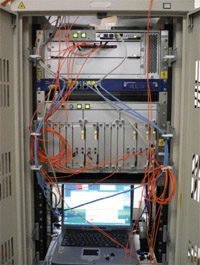The First Application-Driven Lambda-on-Demand Field Trial over a US Nationwide Network
March 5th, 2006
Categories: Networking

Authors
Tsukinama, Y., Hirano, A., Nagatsu, N., Ohara, T., Imajuku, W., Jinno, M., Takigawa, Y., Hagimoto, K., Renambot, L., Jeong, B., Leigh, J., DeFanti, T., Verlo, A., Winkler, L.About
A photonic network comprised of Photonic Cross Connects (PXC) with Generalized Multi-Protocol Label Switching (GMPLS) capability is a promising candidate for the design of next-generation high-performance networks. Extensive efforts [1, 2] are well underway to validate such networks. These reports mainly focus on issues such as multi-vendor interoperability and implement such photonic networks with equipment that fully supports the GMPLS protocol. However, little is done to actually evaluate their performance using real-time bandwidth-intensive applications - which is a key area of focus in the work described in this paper. The National Science Foundation’s Optiputer project [3] has been pursuing the development of data-intensive LambdaGrid applications that utilize the networks as wide-area systems busses connecting clusters of storage, computing and visualization services. The Scalable Adaptive Graphic Environment (SAGE) developed by the Electronic Visualization Laboratory (EVL), the Optiputer’s visualization middleware, can easily scale up to Tbps rendering capacity and is therefore a prime candidate for aggressively evaluating high-performance networks. In such an application, and in LambdaGrid applications in general, dynamic capacity-on-demand without explicit messaging between the applications and the photonic control plane network will highly desirable, since applications will be able to focus on application-specific processing rather than configuring network topologies and characteristics.
In this paper, we present the results of the dynamic lambda-on-demand functionality against the SAGE visualization application over a US nationwide testbed. We used two 10GbE links from Chicago to San Diego. Three PXC systems with GMPLS capability were installed in Chicago and San Diego to form a triangular topology. In addition, we developed control servers to monitor the application traffic on the first lambda and to invoke the automatic activation of the second lambda. The control server with the PXC control-plane (C-plane) automatically configured the number of lambdas and L2 connections to transparently meet the dynamic traffic changes in SAGE.
Resources
Citation
Tsukinama, Y., Hirano, A., Nagatsu, N., Ohara, T., Imajuku, W., Jinno, M., Takigawa, Y., Hagimoto, K., Renambot, L., Jeong, B., Leigh, J., DeFanti, T., Verlo, A., Winkler, L., The First Application-Driven Lambda-on-Demand Field Trial over a US Nationwide Network, Proceedings of OFC / NFOEC 2006 (Optical Fiber Communication/ National Fiber Optic Enginners Conference), Anaheim, CA, pp. PDP48, IEEE / ComSoc, IEEE / LEOS, OSA, March 5th, 2006.